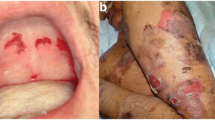Abstract
In 2002, the use of electrical stimulation was approved as an adjuvant treatment for non-healing ulcers. A 50-year-old man with type 2 diabetes of 3 years’ duration was referred to our diabetic foot clinic. The patient was a known case of bullous pemphigoid (BP) for the past 15 years and was under steroid therapy (20 mg/day Prednisolone). Electrical stimulation was used as one of the ancillary methods for the treatment of his chronic diabetic foot ulcers. After two sessions, physical examination revealed a bullous eruption (approximately 14 cm) on an erythematous base in the right leg. The literature is devoid of any case of bullous induced by electrical stimulation in pemphigoid diabetic patients. Further studies are required to validate our observation and fully explain the pathogenesis.


Similar content being viewed by others
References
Center for Medicare and Medicaid Services (CMS). Electrostimulation for wounds. Decision Memorandum #CAG-00068 N. Baltimore, MD: CMS; July 23, 2002. Available at: http://cms.hhs.gov/coverage/8b3-ii3.asp.
Bastuji-Garin S, Joly P, Picard-Dahan C, Bernard P, Vaillant L, Pauwels C, et al. Drugs associated with bullous pemphigoid. A case–control study. Arch Dermatol. 1996;132:272–6.
Sreedevi C, Car N, Pavlic-Renar I. Dermatologic lesions in diabetes mellitus. Diabetologia croatica. 2002; 31:147–59.
Ennis WJ, Lee C, Plummer M, Meneses P. Current status of the use of modalities in wound care: electrical stimulation and ultrasound therapy. Plast Reconstr Surg. 2011;127 Suppl 1:93S–102.
Goldman R, Brewly B, Golden M. Electrotherapy reoxygenates inframalleolar ischemic wounds on diabetic patients. Adv Skin Wound Care. 2002;15:112–20.
Conti M, Peretti E, Cazzetta G, Galimberti G, Vermigli C, Polo R, et al. Frequency modulated electromagnetic neural stimulation enhances cutaneous microvascular flow in patients with diabetic neuropathy. J Diabetes Complicat. 2009;23:46–8.
Asadi MR, Torkaman G, Hedayati M. Effect of sensory and motor electrical stimulation in vascular endothelial growth factor expression of muscle and skin in full-thickness wound. J Rehabil Res Dev. 2011;48:195–202.
Khandpur S, Verma P. Bullous pemphigoid. Indian J Dermatol Venereol Leprol. 2011;77:450–5.
Author information
Authors and Affiliations
Corresponding author
Rights and permissions
About this article
Cite this article
Annabestani, Z., Mohseni, S., Torkaman, G. et al. Electrical stimulation-induced bullous formation in a pemphigoid diabetic patient: a case report. Int J Diabetes Dev Ctries 35, 55–57 (2015). https://doi.org/10.1007/s13410-014-0212-0
Received:
Accepted:
Published:
Issue Date:
DOI: https://doi.org/10.1007/s13410-014-0212-0




